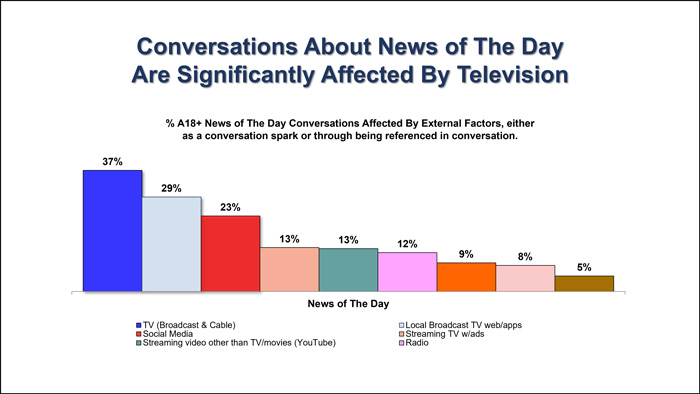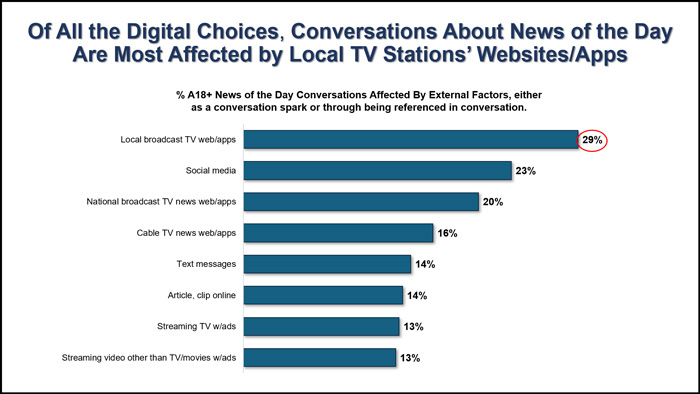TVB member full study and video available – Members must log in to view this additional content.
Request login: Create a TVB member account | Request forgotten password
Word of mouth is a critical influencer and form of marketing. To assess and quantify the role of media in influencing conversations, TVB commissioned GfK/NIQ to conduct the Media & Conversations Study. This was a national study composed of over 4,000 respondents across demographic groups, political party affiliations, races & ethnicities, as well as key consumer product categories.
The study addresses several key questions:
- Which medium is the strongest conversation driver – TV, streaming, radio, social media, podcasts, or newspapers?
- What are people’s attitudes toward news sources regarding trust, believability, shareability and fake news?
- How do media platforms influence political word of mouth?
- What about word of mouth among those who are in the market for products and services like auto, healthcare, home improvement, legal services, physical fitness, restaurants, retail, and travel?
- On what platforms do people prefer to view their sports – linear or streaming?
Key Findings:
- Eight out of ten respondents have daily conversations about topics that local broadcast TV station newscasts cover.
- Adults have more conversations about the news of the day than they do about products,services and entertainment.
- Media affects conversations:
- TV is critical in sparking and supporting conversations about the news of the day, local/regional news, weather, sports, traffic, and politics. It is the dominant driver of these conversations compared with ad-supported streaming platforms, social media, print, radio, podcasts and direct mail.
- Of all the digital choices, conversations about the news of the day are most affected by local TV stations’ websites/apps.
- Respondents said that broadcast TV news is their primary news source:
- They also found local broadcast news assets to be the most shareworthy, trustworthy and believable. This was also true among key age demos, high-net-worth homes, and consumer categories.
- They found social media to be the least trustworthy and believable, and they strongly associate it with fake news.
- Local broadcast TV news ranks #1 in increased trustworthiness compared to last year, while social media ranks first in decreased trustworthiness.
- Across key product categories, respondents select broadcast TV as the media that sparks or is referenced most in their daily conversations.
- TV and local news are integral parts of everyday life and generate feelings of closeness, familiarity, and trust.
- Across the spectrum of professional and college sports, respondents overwhelmingly chose linear TV over streaming sources as their viewing source.
- Regardless of political affiliation, respondents chose TV as having the biggest impact on their daily conversations about news.

Q8/9 “Which one of the following comes closest to describing what prompted or “sparked” or referenced the conversation about the topic?

Q8/9 “Which one of the following comes closest to describing what prompted or “sparked” or referenced the conversation about the topic?
For more information, please contact Hadassa Gerber, Chief Research Officer, TVB.
